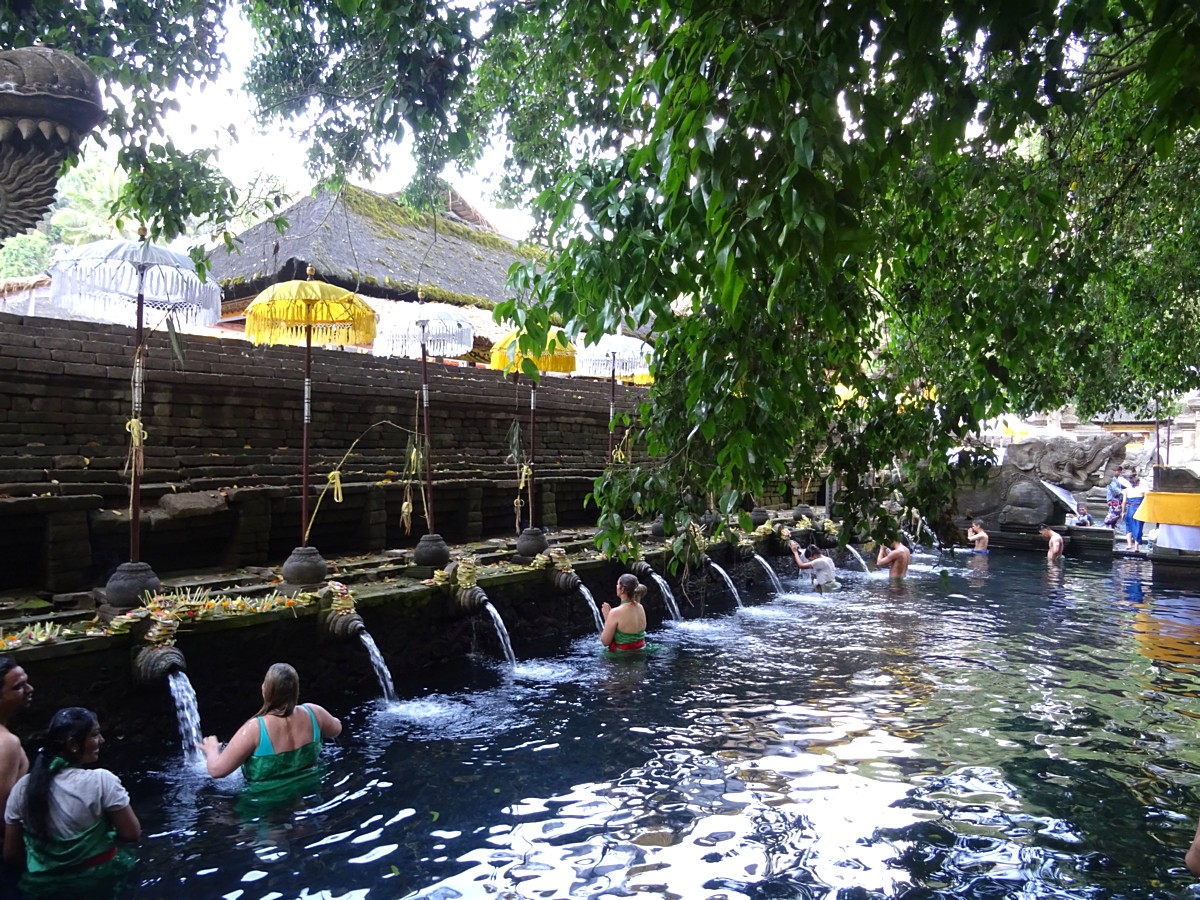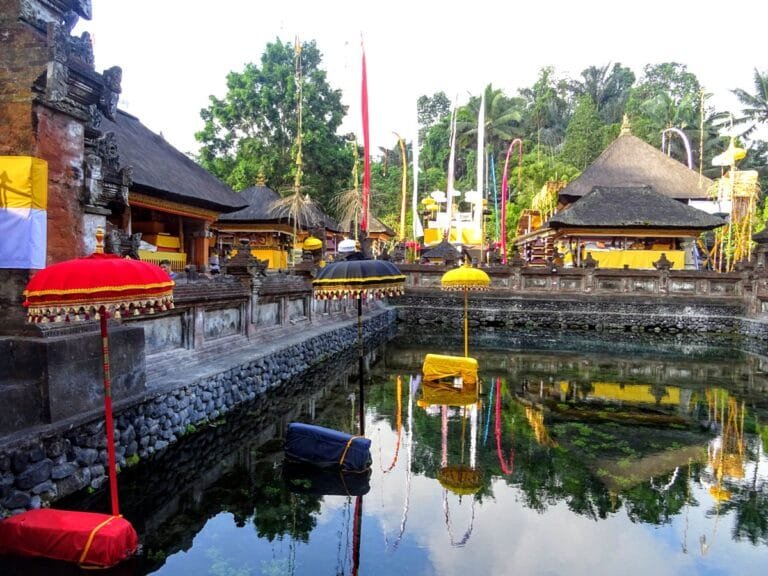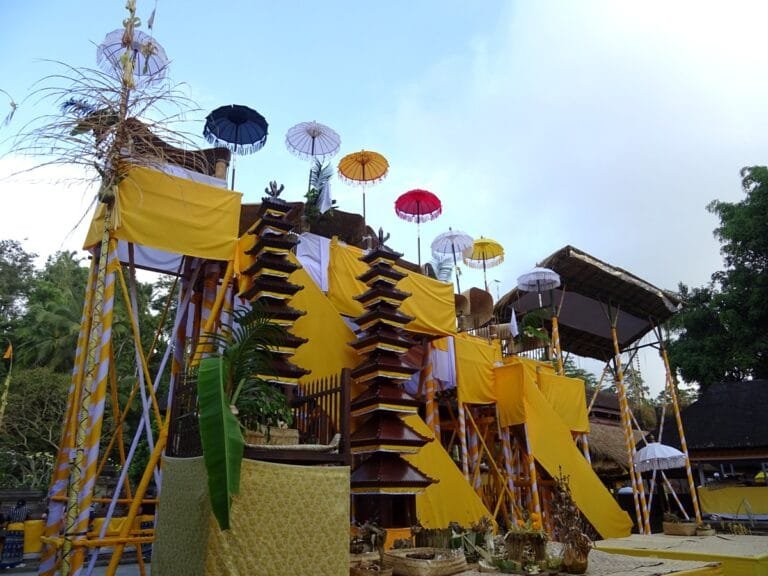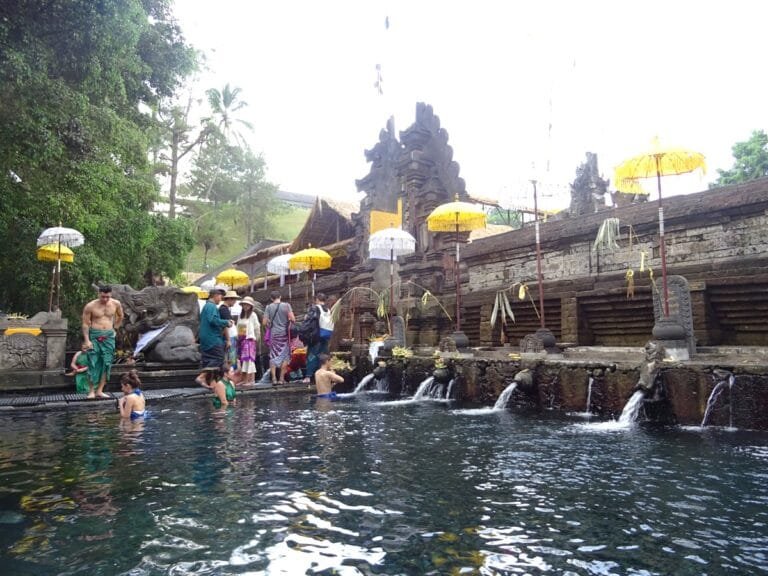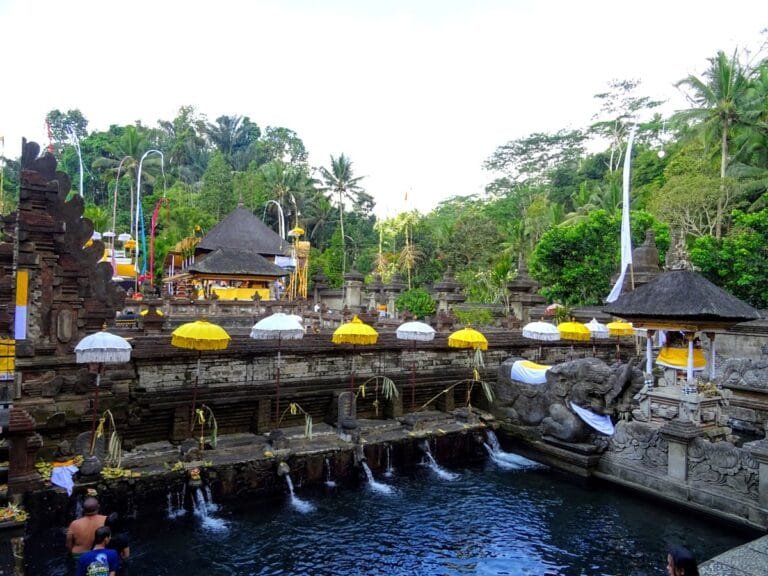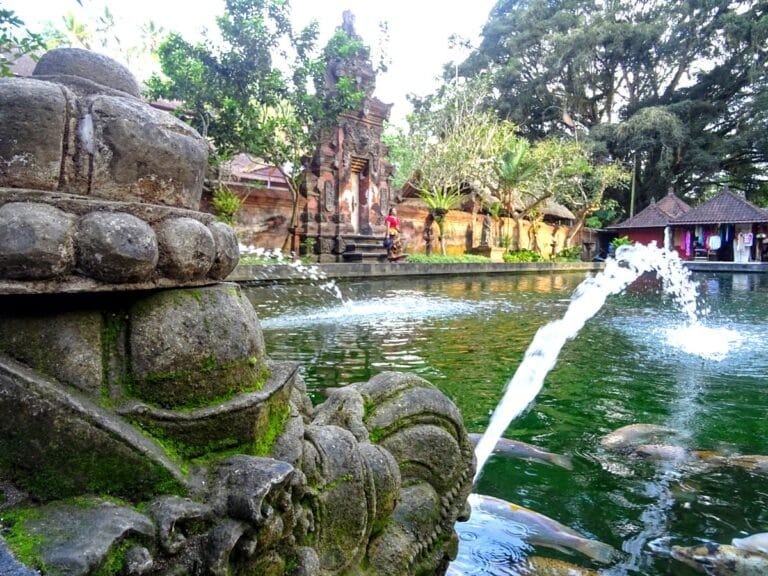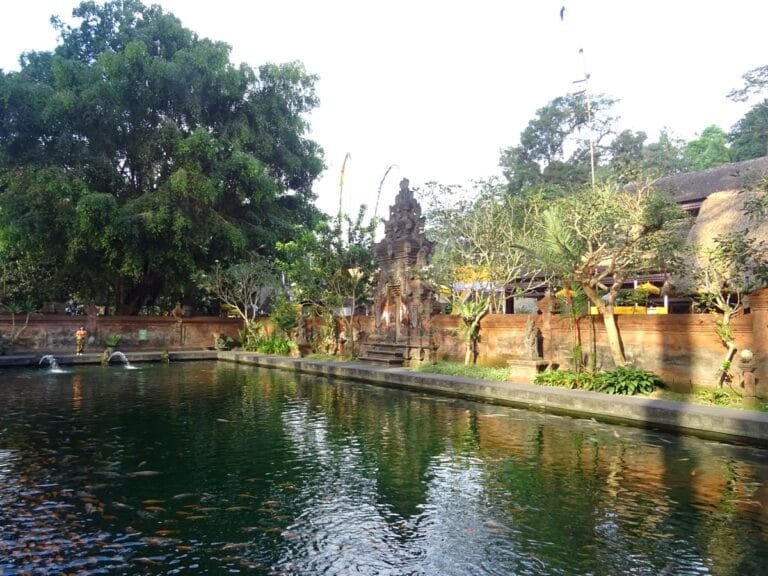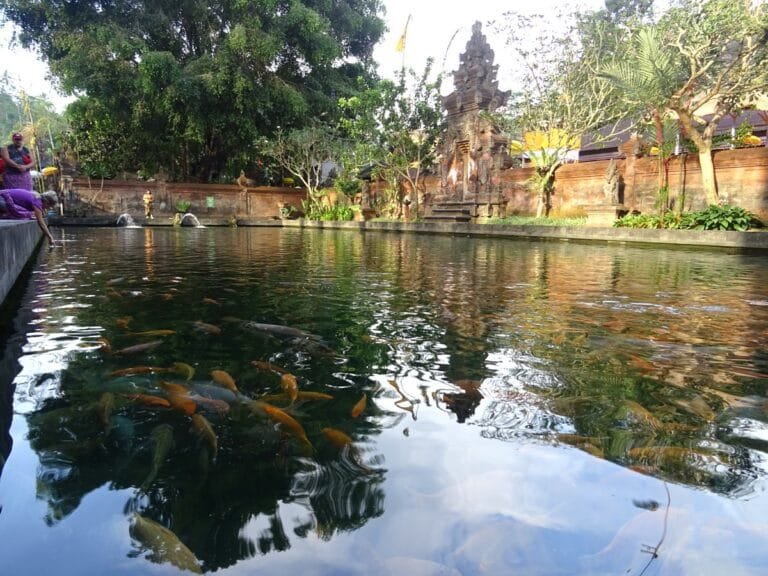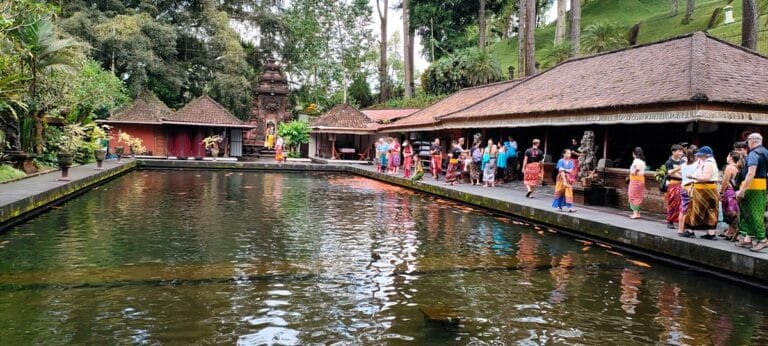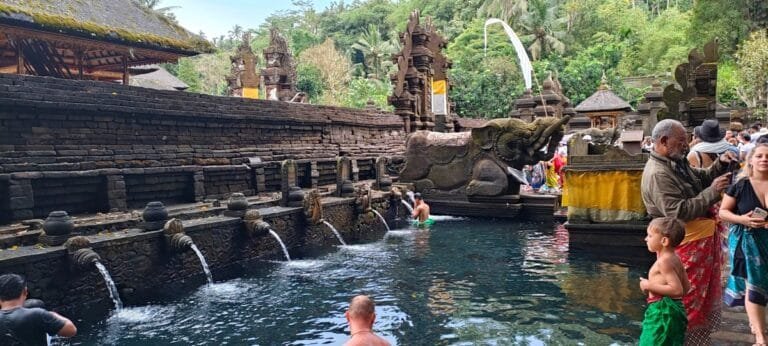Where sacred springs flow with healing waters, Tirta Empul Temple offers a profound spiritual experience in the heart of Bali.
Bali’s Sacred Water Temple of Purification
Located in the village of Manukaya, near Tampaksiring in central Bali, Tirta Empul Temple is one of the island’s most important spiritual landmarks. Known for its sacred spring water, which is used in purification rituals, the temple is a revered site for both Balinese Hindus and visitors seeking a deeper connection with Bali’s spiritual traditions. The name “Tirta Empul” means “holy water spring,” and for more than a thousand years, the temple has been a place of worship, healing, and cleansing.
Set amidst lush tropical surroundings, the temple complex is a serene and beautiful destination, offering visitors an opportunity to witness traditional Balinese religious ceremonies and participate in the ancient ritual of melukat, or spiritual purification. With its holy waters, intricate stone carvings, and deep spiritual significance, Tirta Empul Temple is a must-visit destination for those exploring Bali’s rich cultural heritage.
The History of Tirta Empul Temple
Tirta Empul Temple was founded in 962 AD during the reign of the Warmadewa dynasty. The temple’s natural spring is believed to have been created by the god Indra, who pierced the earth to bring forth holy water to revive his defeated soldiers. According to Balinese legend, the spring’s healing powers were used to counteract the poisonous water created by the demon king Mayadenawa during a great battle.
The temple was constructed around the spring and has served as a place of purification and healing ever since. The water from the spring is considered sacred, and Balinese Hindus come to the temple to purify themselves, seek blessings, and perform rituals to cleanse their bodies and spirits.
In addition to its religious significance, Tirta Empul Temple is also known for its historical connection to Tampaksiring Palace, a presidential palace located near the temple complex. The palace was built in 1957 by Indonesia’s first president, Sukarno, and is still used for official state functions today.
The Layout of Tirta Empul Temple
Tirta Empul Temple is divided into three main sections, reflecting the traditional Balinese temple layout: Jaba Pura (the outer courtyard), Jaba Tengah (the central courtyard), and Jeroan (the inner sanctum).
Jaba Pura (Outer Courtyard)
The Jaba Pura is the outer section of the temple, where visitors first enter. This area contains beautiful tropical gardens and pathways leading to the central courtyard. The entrance to the temple is marked by a traditional candi bentar (split gate), which is flanked by stone statues of gods and mythological creatures.
Jaba Tengah (Central Courtyard)
The Jaba Tengah is the most important part of the temple, as it contains the holy bathing pools where the purification rituals take place. The water from the sacred spring flows into two large rectangular stone pools, each lined with a series of carved spouts that release the water. Each spout is believed to have its own specific spiritual purpose, and worshippers move from spout to spout, immersing themselves in the holy water as part of the purification process.
The purification ritual is known as melukat and is performed by both locals and visitors seeking spiritual cleansing and healing. Participants stand in the pools, often in traditional sarongs, and wash themselves under each spout in a specific order, offering prayers for health, prosperity, and peace.
TIP: If you wish to participate in the purification ritual, it’s important to dress modestly and wear a sarong and sash, which can be rented or purchased at the entrance. Be respectful of the local customs and follow the instructions of the temple staff or your guide to ensure you perform the ritual correctly.
Jeroan (Inner Courtyard)
The Jeroan is the innermost sanctum of the temple, where more private ceremonies and offerings take place. This area is reserved for worshippers, and while visitors can walk around the perimeter, they are not allowed to enter the inner sanctum itself. The Jeroan contains shrines dedicated to various Hindu gods, including Indra, and is where Balinese Hindus come to make offerings and pray for blessings.
The intricate stone carvings and statues throughout the temple depict scenes from Hindu mythology, adding to the spiritual and artistic richness of the site.
The Holy Spring: Source of Sacred Water
The heart of Tirta Empul Temple is the holy spring, located in a separate section behind the bathing pools. The spring water flows naturally from the ground and is channeled into the purification pools and other areas of the temple. The water is crystal clear, and you can see the spring bubbling up from beneath the earth, creating a peaceful and sacred atmosphere.
The holy water from the spring is considered to have healing powers and is used in religious ceremonies, not only at Tirta Empul but also in temples and rituals across Bali. Balinese Hindus believe that bathing in the sacred water can cleanse both the body and spirit, washing away negative energy and bringing good fortune.
TIP: Even if you do not participate in the purification ritual, visiting the holy spring is a powerful experience. The serene environment and the significance of the water to the local culture and religion are awe-inspiring.
Cultural and Spiritual Significance
Tirta Empul is not just a tourist attraction—it is a deeply spiritual place for the Balinese people. For more than a thousand years, the temple has been a center for worship and purification, and it remains a vital part of Bali’s religious life today. The temple is busiest during important Balinese festivals and religious holidays, such as Galungan and Kuningan, when thousands of Balinese Hindus come to the temple to bathe in the holy waters and make offerings.
The temple also plays a central role in the Balinese belief in Tri Hita Karana, a philosophy that emphasizes the importance of maintaining harmony between humans, nature, and the gods. Tirta Empul is a place where these three elements converge, offering a space for spiritual reflection and renewal.
TIP: If you visit during a religious ceremony, you’ll have the chance to witness the temple at its most vibrant, with worshippers dressed in traditional clothing, carrying offerings, and praying at the shrines. However, be sure to show respect for the local customs and rituals, and follow any instructions given by the temple staff.
A Sacred Journey into Bali’s Spiritual Heart
Visiting Tirta Empul Temple offers more than just a glimpse into Bali’s rich spiritual traditions—it’s an opportunity to experience the island’s deep connection to water, purification, and the divine. Whether you choose to participate in the purification ritual or simply explore the serene temple grounds, Tirta Empul provides a peaceful and enriching experience that leaves a lasting impression.
The combination of sacred water, beautiful temple architecture, and the profound sense of spirituality makes Tirta Empul one of Bali’s most cherished religious sites. For travelers seeking to understand the cultural and spiritual essence of Bali, a visit to Tirta Empul Temple is an essential part of any journey.




